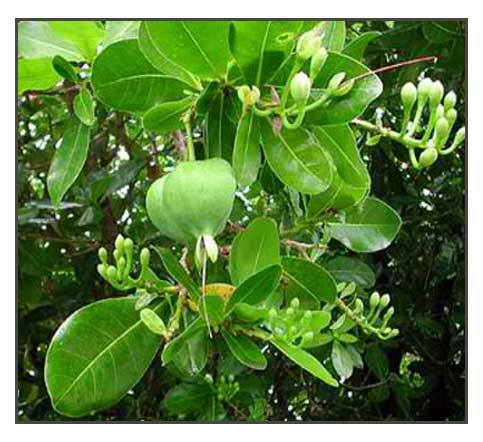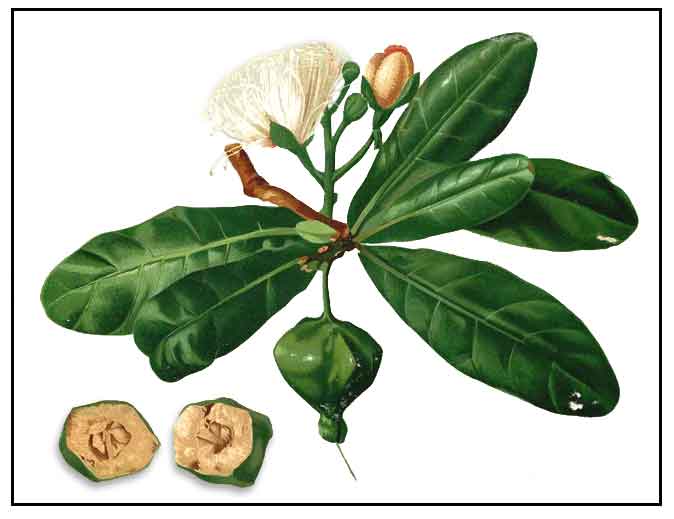 Gen info Gen info
- Barringtonia asiatica is a species of Barringtonia native to mangrove habitats from islands of the Indian Ocean in the west to tropical Asia and islands of the western Pacific Ocean.
- The local name futu is the source of name for the Polynesian island Futuna. (25)
- It was described by Carl Linnaeus in his Species Plantarum in 1753, and reassigned to the genus Barringtonia by Wilhelm Kurz in 1875. (25)
Botany
Botong is a tree growing to a height of 8 to 15 meters. Leaves are large, obovate or obovate-oblong, 20 to 40 centimeters long, entire, thick, shining, stalkless, blunt-tipped, and pointed at the base. Flowers are very large and white, borne in short, erect, few-flavored racemes. Calyx-tube is about 1 centimeter long; the lobes, 2 or 3, are oblong-ovate, concave, green and about 2.5 centimeter long. Petals are deciduous, four, thin, first white and then brownish, oblong, 7 to 8 centimeters long, and 3 to 4 centimeters wide. Stamens are very numerous, slender and united at the base, 10 to 12 centimeters long, white below, and shading to purple above. Anthers are small and yellow. Fruit has a typical tetragonal lantern shape, 8 to 14 centimeters long and 8 to 12 centimeters thick, containing one large seed.
 Distribution Distribution
- Native to the Philippines.
-
A common strand plant along the seashore throughout the Philippines.
- Cultivated as a shade tree along boulevards and avenues by the sea.
- Also found within tropical Asia to Polynesia.
- Also native to Andaman Is., Bismarck Archipelago, Borneo, Cambodia, Caroline Is., Chagos Archipelago, Cocos (Keeling) Is., Comoros, Cook Is., Fiji, Gilbert Is., India, Jawa, Lesser Sunda Is., Line Is., Madagascar, Malaya, Maldives, Maluku, Marianas, Marquesas, Marshall Is., Mauritius, Nansei-shoto, Nauru, New Caledonia, New Guinea, Nicobar Is., Niue, Ogasawara-shoto, Queensland, Réunion, Samoa, Santa Cruz Is., Seychelles, Society Is., Solomon Is., South China Sea, Sri Lanka, Sulawesi, Sumatera, Taiwan, Tanzania, Thailand, Tokelau-Manihiki, Tonga, Tuamotu, Tubuai Is., Tuvalu, Vanuatu, Vietnam, Wallis-Futuna Is.
(9)
Constituents
- Seeds contain 2.9 percent of fixed oil, consisting of olein, palmitin, and stearin; gallic acid, 0.54 percent; a glucoside, barringtonin, 3.271 per cent.
- Preliminary work on saponins from B. asiatica showed the seeds contain a mixture of saponins (A1-barrinin).
- Study isolated a triterpene ester saponin from the seed of B. asiatica.
- Study of methanol extract of seeds yielded two major saponins, elucidated as 3-O-{[β-d-galactopyranosyl(1→3)-β-d-glucopyranosyl(1→2)]-β-d-glucuronopyranosyloxy}-22-O-(2-methylbutyroyloxy)-15,16,28-trihydroxy-(3β,15α,16α,22α)-olean-12-ene (3) and 3-O-{[β-d-galactopyranosyl(1→3)-β-d-glucopyranosyl(1→2)]-β-d-glucuronopyranosyloxy}-22-O-[2(E)-methyl-2-butenyloyloxy]-15,16,28-trihydroxy-(3β,15α,16α,22α)-olean-12-ene (4). (see study below) (6)
- Study of dichloromethane extract of Barringtonia asiatica leaves for essential oil yielded major pytochemicals like
uncineol 30.9%, eicosane 27.4%, eicosane 21.6%, and 4-propyl-guaiacol 14.05%. (see study below) (24)
- Study of leaves of yielded two new triterpenes, germanicol caffeoyl ester (1) and camelliagenone (2). Study also afforded germanicol trans-coumaroyl ester (3), germanicol cis-coumaroyl ester (4), germanicol (5), camelliagenin A (6), spinasterol, sitosterol, squalene, lutein and trilinolein. Compounds 3, spinasterol and trilinolein were isolated isolated from the fruits, while seeds yielded spinasterol, squalene, linoleic acid, and trilinolein. (see study below) (26)
 Properties Properties
- Known ichthyotoxic.
- Studies have shown antitumor, antifungal, antiepileptic, antibacterial, antioxidant, wound healing, ichthyotoxic, anti-dengue, anticancer properties.
Toxicity
- All parts of the tree are poisonous. The seeds are ground to a powder and used to stun or kill fish, suffocating the fish while the flesh is unaffected.
Parts used
Leaves, seeds, bark.
Uses
Edibility
- Pods reportedly eaten in Indo-China.
- Caution: Raw seeds reported to be poisonous to eat.
Folkloric
- In the Philippines, leaves are heated and applied as topicals for stomachache.
- Fresh leaves used as topicals for rheumatism.
- Seeds employed as vermifuge.
- Scraped content of the fruit used for cysts, goiter, abscesses, tumors. Scrapings are applied as a
poultice or held inside a cloth.
-
Extract from dried kernel drunk to treat coughs, sore throat, bronchitis, infuenza, and diarrhea.
- Besides use as fish poison, the Nicobari tribe of India used the leaves for then treatment of fractures, wounds, de-worming, and pain relief.
(10)
 - Mixture of young leaves of B. asiatica and Morinda citrifolia are squeezed into water and drunk to relieve stomach ache. Fresh leaves heated and applied on fresh cuts and chronic infected skin conditions. Sliced seed applied on sores. Dried seed considered highly poisonous and used in suicide attempts. (11) - Mixture of young leaves of B. asiatica and Morinda citrifolia are squeezed into water and drunk to relieve stomach ache. Fresh leaves heated and applied on fresh cuts and chronic infected skin conditions. Sliced seed applied on sores. Dried seed considered highly poisonous and used in suicide attempts. (11)
- In the Cook Islands, grated seeds mixed with coconut cream rubbed onto burns. In Fiji, leaf decoction used for treatment of hernia. Bark decoction use to treat constipation and epilepsy. - In Samoa, used in the treatment of skin sores. Fruit ands bark use to treat yaws; seeds used for ringworm; bark used in treating tuberculosis. (12)
- In Ayurveda, used for burns, wounds, stomachache, rheumatism, worm infections, malarial splenomegaly, and tuberculosis. (19)
Others
- Fish poison: In Indo-China, fruit used as fish poison. (see study below 10) In Solomon Islands and Samoa, used to stun fish. (12)
- Oil: In the Moluccas, oil is extracted from the seeds and used as illuminant.
- Wood: Used for construction of canoes and wooden houses, handicraft items. Also as firewood. (10)
 Studies Studies
• Antitumor / Phytochemicals: Study evaluated the biological activity of the seeds of Barringtonia asiatica using the brine shrimp hatchability and lethality assay. Results showed high biological activity in both assays and suggests the possibility that botong seeds contain compounds that can be used to treat cancers and tumors. Phytochemicals yielded terpenoids and saponins. (2)
• Antifungal: Crude methanolic extract of leaves, fruits, seed stems and root barks of B. asiatica showed a good level of broad spectrum antifungal activity. The methanolic extract of B. asiatica flower also activity against M. cais and T. rubrum. (3)
• Saponins / Antifeedant Towards Epilachna sp. Larvae / Seeds: Methanol extract of seeds yielded two major saponins. Study discussed the antifeedant properties towards Epilachna larvae are discussed. (see constituents above) (6)
• Anti-Epileptic Activity: Study evaluated a methanolic extract of B. asiatica for acute toxicity testing and antiepileptic activity. in albino Wistar rats. The extract showed antiepileptic activity in both MES (Maximal Electroshock) and PTZ (Pentylenetetrazole) induced seizure models. Possible mechanism may be mediation through chloride channel of GABA or benzodiazepine receptor complex. (7) Study showed significant delay in clonic seizure induced by PTZ and dose dependent decrease in duration of hindleg extension phase in MES model. Acute toxicity study of extract showed no toxicity up to recommended dose of 2000 mg/kbw orally per OECD guidelines. (23)
• New Triterpene / Antimicrobial Activity: Study of freeze-dried bark of B. asiatica yielded a new triterpene: 3ß,11α)-11-hydroxyolean-12-en-3-yl palmitate, together with mixtures of other compounds. The compounds showed slight activity against C. albicans. Some compounds showed slight activity against S. aureus and P. aeruginosa. (8)
• Traditional Uses of Ichthyotoxic Plant: Study reports on traditional uses of the ichthyotoxic plant by the Nicobari tribes from the Car Nicobar Island of India. Seeds were used for killing fishes, octopus, etc. (Despite the killing of fish by narcotization, no human beings were affected by consuming the narcotized fish [Stokes, 1921]). After the 2004 tsunami, the popularity of fishing method diminished. Besides its use in harvesting fishes, study reports on the utilization of other plants parts for use in fractures, wounds, de-worming, and pain relief in human beings, besides the variety of uses for the wood. (10)
• Oleanane Glycoside / Piscicidal: Study elucidated a new oleanane glycoside, ranuncoside VIII, 3-O-{[ß-D-galactopyranosyl-(1.3)-2-ß-D- glucopyranosyl-(1.2)]-ß-D-glucuronopyranosyloxy}-21-O-{[(2E)-2-methyl-1-oxo-2- butenyl]oxy}-22-O-(2-methyl-1-oxobutoxy)-15,16,28-trihydroxy-(3ß,15a,16a,22a)-olean-12- ene. The compound demonstrated significant piscicidal activity in a model assay. (14)
• Triterpenoid Saponin / Seeds: Study of a seed extract produced a white, oily, semi-solid compound that yielded compounds of alkaloid, saponin, triterpenoid, and tannin. Seeds yielded three triterpenoid saponin compounds viz., 2.4-bis-(1.1-dimethyl ethyl)-, methylcarbamate; 4-Dodecylphenol; and 2.6 bis-(1.1-dimethylethyl)-4-methyl-, methylcarbamate, with the potential to be biopesticidal. (15)
• Anti-Dengue / Biolarvicide Activity on Aedes Aegypti / Seeds: Study evaluated the effectiveness of vegetable insecticide extracts of hutun (Barringtonia asiatica Kurz.) seeds on larvae of dengue hemorrhagic fever (DHF) vector Aedes aegypti mosquito. Results showed the methanol extract of hutun seeds is an active larvicide effectively killing larvae of Ae. aegypti with death concentration value LC50 of 35.572 ppm. (16)
• Cytotoxicity in Artemia salina / Seeds: Study evaluated the crude water extract of botong seeds for biologic activity using brine shrimp hatchability and lethality assay. Crude extracts yielded terpenoids and saponins. Results showed high biological activity in both assays with an LC50 better than positive control. Findings suggest the presence of seed compounds with potential biologic activity for the treatment of cancer or tumor. (17)
• Fixed Oil / Alternative Fuel: Seeds yield about 2.9% fixed oil, including olein, palmitin, and stearin, 0.54% of gallic acid, and a glucoside, barringtonin 3.271%, which can be considered a potential alternative fuel. This extraction study showed that castor beans had a higher percentage yield than that of Botong nut samples; however both fruit samples yielded similar results. Protease enzymes showed higher yield than pectinase enzymes because of higher amounts of protein in both samples. (18)
• Larvicidal / Spodopthera litura / Seeds: Study evaluated the effectiveness of methanol extract from keben seeds (B. asiatica) on mortality of Spodopthera litura larvae on soybean plant. Results showed the seed extract was quite effective in suppressing the intensity of damage in leaves caused by S. litura on soybean plant. Pretreatment showed significant impact on mortality of S. litura instar II. (20)
• Wound Antiseptic / Leaves: Study evaluated the effectiveness of B. asiatica leaf extract as an antiseptic in treating wound and its effect on healing time and microbial growth. Results showed the B. asiatica leaf extract was effective as wound antiseptic in mice. Leaf extract treatment hastened the healing of wounds. Microbial count was highest in the control, lower with the leaf extract, and least with betadine. There was no significant difference found between the effects of B. asiatica leaf extract and commercial antiseptic in mice. (21)
• Wound Healing / Bark: Study evaluated the wound healing activity of bark of Barringtonia asiatica in simple ointment formulation of 2% and 4% (w/w) in three types of rat models viz., excision, incision, and burn wound model. Results showed remarkable wound healing activity, comparable to standard drug, nitrofurazone in measures of wound contracting ability, wound closure time, and tensile strength. The 4% w/w alcoholic extract exhibited significant (p<0.001) wound contracting ability and period of epithelization. (22)
• Antibacterial / Antioxidant / Leaf Essential Oils: Study evaluated the antibacterial and antioxidant properties of essential oil of dichloromethane crude extract of B. asiatica leaves. The extract showed broad spectrum antibacterial activity against Salmonella typhi, Escherichia coli, Staphylococcus aureus, and Klebsiella pneumoniae with inhibition values range between 2.50 and 5.00 mm. The dichloromethane extract also exhibited strong antioxidant activities by DPPH assay. (see constituents above) (24)
• Antibacterial Triterpenes / Leaves: Study of leaves of B. asiatica yielded two new triterpenes, germanicol caffeoyl ester (1) and camelliagenone (2). Study also afforded germanicol trans-coumaroyl ester (3), germanicol cis-coumaroyl ester (4), germanicol (5), camelliagenin A (6), spinasterol, sitosterol, squalene, lutein and trilinolein. Compounds 3, spinasterol and trilinolein were isolated isolated from the fruits, while seeds yielded spinasterol, squalene, linoleic acid, and trilinolein. Compounds 1-5 exhibited antifungal activity against Candida albicans, while 1-3 and 5 showed antibacterial activity against S. aureus. Compound 5 was active against Pseudomonas aeruginosa. (26)
• Cytotoxicity / Anticancer / Ovarian Carcinoma A2780 / Seeds: Study of investigated the cytotoxic effect of B. asiatica seed extract against ovarian carcinoma A2780 and Saccharomyces cerevisiae as cancer model organism. Findings revealed anticancer activity and capability to induce G1 cell cycle arrest in S. cerevisiae. Results suggest a potential source of natural compounds for anticancer drug discovery. (27)
Availability
- Wild-crafted.
|

![]()







 Studies
Studies 